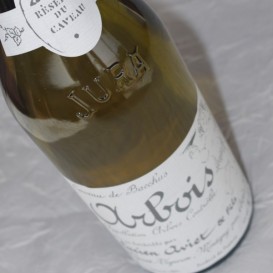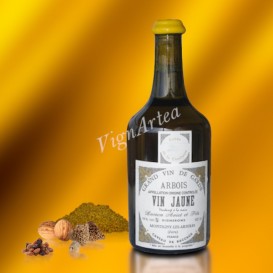Caveau de Bacchus - Lucien AVIET et Fils

JURA 5 ha SUSTAINABLE FARMING WINEMAKER : Vincent Aviet
ESTATE STORY
Back from the Algerian war in 1960, Lucien made his decision : he will be a wine-grower and to do so, he asked his mother the permission to exploit the small hectare of vines she had inherited a century earlier. He explained the origin of this small vines plot in an article in L'Humanité magazine on February the 9th, 2002: " We found traces of someone called Aviet who cultivated the vine in Montigny in 1447. Not a winegrower, but a serf who maintained the vines of the Cîteaux monks, owners of a large part of the village lands. This will be the case until the last century when my parents inherit a 1 ha plot, what was enough for these farmers of an another time that bred four cows. Wine was very important, it was a source of calories that allowed a man to do the hard work that agriculture required. My story with wine begins very early when, between the potatoes fields and the stables, I spent years hoeing, taking care of this vine, and producing these wines, still unknown at this time. "
In 1968, he founded with friends who were geologists La Confrérie de Bacchus, an association which brings together each year these lovers of the Montigny-lès-Arsures lands and its wine. The fellows who join it will gradually make Lucien wines known, sometimes at a picnic in the forest, sometimes during a small trip organized by the brotherhood.
The estate slowly grew, year after year, and in 1990, Lucien was joined by his son Vincent, and they baptized together the estate Caveau de Bacchus.
TERROIR
The vineyard, made up of 50% red grape varieties (Trousseau, Ploussard) and 50% white grape varieties (Melon à Queue Rouge, Savagnin), is spread over the most beautiful terroirs of Montigny-lès-Arsures. The soils have a substrate dating from the Triassic end (-240 million years), up to the middle of the Jurassic (-174 million years) : these are the famous Trias marls and Lias marls which were deposited in a marine environment when the sea covered the region. The climatic changes and the tectonic movements which took place during this period of the Earth history caused bathymetric variations and modifications of the oxygen rate in the water which explain the great diversity of the marls color and structure, sometimes iridescent, sometimes gray then black, and sometimes with a foliated structure.
It is rare to see these marls outcrop on the surface, most of the time they are covered by a thick layer of sediments coming from millions years of erosion.
The Triassic marls, which outcrop at the slopes bottom, are often covered with a thick layer of runny silt or limestone scree wrapped in a more or less abundant clay matrix, depending on the location, while the Lias marls present on the slopes, are covered with a thick limestone scree layer coming from the erosion of the ledge which overhangs them, with in places a thick bed of clay with chailles : the chailles are small, silky kidneys of organic origin that erosion has released from their calcareous envelope and disseminated in the midst of decalcification clays.
Some plots are located on a limestone soil which outcrops in rare places and which are called encrinal limestones : this limestone bench marks the transition between the Triassic marls and the Lias marls, and testify to a period during which the shallow seas are more agitated, favoring a strong environment oxygenation and a better carbonates precipitation : the waters were populated by small arched oysters, called gryphées, that are now fossilized in the limestone bank.
Each terroir its grape variety : The Trousseau, a very demanding grape variety to reach a good maturity appreciates the clay with chailles soils which covers the Lias gray marls ; The Poulsard variety prefers the iridescent Triassic marls, because the root penetration is facilitated. The Savagnin, on the contrary, gives the best of itself in the Lias gray marls, and more precisely when their structure is foliated : they are called the "paper shales" marls.
Chardonnay, on the other hand, is not very demanding in term of soil, but its wines have a distinct aromatic profil depending on the terroir nature, and it gives excellent results in soils rich in scree that are found at the limestone ledge base.
The estate vines are around 30 to 60 years old, and all come from sélection massale : this reproduction technique consists of cutting the mother plant branch, making it possible to keep intact its genetic heritage. They are cultivated according the sustainable agriculture principles, chemical treatments are only used when it is necessary, and the harvest is done manually.
WINEGROWING & WINEMAKING
You probably noticed that the estate produces wines called "Cuvée des Géologues ", "Cuvée des Docteurs ", "Réserve du Caveau " or "Cuvée de la Confrérie ". These names were not chosen at random, they bear witness to a more than 40 years long friendship between Lucien Aviet and the students from the region, who came to help him harvest the grapes when he started its wine-growing activity. To thank them for their precious help, Lucien gave them a drink : the geologists liked his rich and consistent Trousseau wines, which helped them to regain strength, while the doctors preferred his more delicate Chardonnay and Ploussard wines : so are born the "cuvées des Géologues" and "cuvées des Docteurs" !
In terms of winemaking, simplicity is essential : alcoholic fermentations take place with the native yeasts and in temperature-controlled vats. Nothing other than sulphites is added to the must. The red wines as well as the Chardonnay wines are aged in casks for one year while the Savagnin carries out an oxidative ageing : 4 years of veil ageing for the cuvée "Réserve du Caveau" and 8 years of veil aging for the Vin Jaune (or "cuvée de la Confrérie").
The oxidative ageing is a process which consists in not filling the barrels with young wine when the latter evaporates. Contact with oxygen increases as evaporation, a yeast veil is then forming on the must surface, giving it an isolating protection from the ambiant oxygen, thus avoiding acetic souring. The yeasts work gives these wines some very characteristic aromas of nuts, morels and curry, and an extraordinary cellar potential of over one hundred years, without resorting to any sulfiting process.

-
TROUSSEAU BRUYÈRES ROSIÈRE 2022 - Cuvée des Géologues (Lucien AVIET & fils)
44,50 € In stock!JURA - AOP ARBOIS - RED WINE
Grape variety: Trousseau (100%)
Native yeasts Ageing in barrels for 1 year
- Nose: fruity. Aromas of red and black fruits, violets, with a hint of balsamic notes.>
- Palate: structured by fine tannins. Suitable for a long cellar ageing.
- Tasting date: February 2024.
- OUR OPINION: a very fruity vintage, which can be kept in the cellar for 2 to 3 extra years to gain in suppleness. Need some fresh air before tasting.
- Nose: fruity. Aromas of red and black fruits, violets, with a hint of balsamic notes.>
-
MELON À QUEUE ROUGE 2022 - Cuvée des Docteurs (Lucien AVIET & fils)
33,50 € In stock!JURA - AOP ARBOIS - DRY WHITE WINE
Grape variety: Melon à queue rouge (100%)
Native yeasts Ageing in barrels for 1 year
- Nose: unctuous. Notes of almond and white grapefruit with a hint of anise.
- Palate: rather round with a fleshy texture.
- Tasting date: February 2024.
- OUR OPINION: 2022 is a hot and dry vintage. The acidity is a little less sustained than usual, and the profile is more unctuous on the palate.
- Nose: unctuous. Notes of almond and white grapefruit with a hint of anise.
-
SAVAGNIN 2016 - Réserve du Caveau (Lucien AVIET & fils)
54,00 € OUT OF STOCK!OUT OF STOCK!JURA - AOP ARBOIS - DRY WHITE WINE
Grape variety: Savagnin (100%)
Native yeasts
Under flor ageing in 228 liters barrels and half-muid for 4 years- Nose: candied citrus (orange, grapefruit), nuts, raisins, with a pinch of curry
- Palate: full, tasty, and aromatic. Persistent finish.
- Tasting date: tasting notes of the 2014 vintage.
- OUR OPINION: the tiny quantities supplied do not allow me to sacrifice a bottle for tasting. As those wines are of impeccable quality year after year, I wrote the tasting notes of the 2014 vintage as an indication.
- Nose: candied citrus (orange, grapefruit), nuts, raisins, with a pinch of curry
-
MELON À QUEUE ROUGE 2020 - Cuvée des Docteurs (Lucien AVIET & fils)
32,90 € In stock!JURA - AOP ARBOIS - DRY WHITE WINE
Grape variety: Melon à queue rouge (100%)
Native yeasts Ageing in barrels for 1 year
- Nose: discreet and subtle. Aniseed notes, lemon and almond aromas.
- Palate: lively and tonic, slightly pearly on the tip of the tongue.
- Tasting date: February 2023.
- OUR OPINION: a thirst-quenching and delicate vintage, nicely perfumed.
- Nose: discreet and subtle. Aniseed notes, lemon and almond aromas.
-
TROUSSEAU MARNE ROUGE 2020 - Cuvée des Géologues (Lucien AVIET & fils)
43,30 € In stock!JURA - AOP ARBOIS - RED WINE
Grape variety: Trousseau (100%)
Single plot's wine Native yeasts
Ageing in barrels for 1 year- Nose: intense, tasty and spicy. Notes of black pepper, coffee, blueberry and strawberry.
- Palate: lightly wooded. Juice underlined by tannins of a great delicacy. Slightly liquorice finish.
- Tasting date: January 2023.
- OUR OPINION: it well deserved its gold medal at the Paris competition! This trousseau is tasty as one could wish, well balanced, as I like them !
- Nose: intense, tasty and spicy. Notes of black pepper, coffee, blueberry and strawberry.
-
TROUSSEAU 2021 - Cuvée des Géologues (Lucien AVIET & fils)
37,30 € In stock!JURA - AOP ARBOIS - RED WINE
Grape varieties: Trousseau (80%) - Ploussard (20%)
Native yeasts Ageing in barrels for 1 year
- Nose: intense and tasty. Aromas of redcurrant, strawberry, blueberry, black pepper, cinnamon.
- Palate: fresh, silky and juicy. Slight bitter perception on the finish.
- Tasting date: January 2023.
- OUR OPINION: very nice this trousseau, to be drunk chilled (12°C). It is tasty and thirst-quenching. Let's not forget that this Trousseau contains 20% of Poulsard which certainly brings it some roundness and fruitiness.
- Nose: intense and tasty. Aromas of redcurrant, strawberry, blueberry, black pepper, cinnamon.
-
VIN JAUNE 2014 - Cuvée de la confrérie (Lucien AVIET & fils)
89,00 € OUT OF STOCK!OUT OF STOCK!JURA - AOP ARBOIS - DRY WHITE WINE
Grape variety: Savagnin (100%)
Native yeasts
Ageing under flor in 228 liters barrels and half-muid for 7 years- Nose: morel, fresh nuts, raisin and curry.
- Palate: elegant and tonic. Persistent finish reminiscent of whisky.
- Tasting date: tasting notes of the 2013 vintage.
- OUR OPINION: the tiny quantities supplied do not allow me to sacrifice a bottle for tasting. As those wines are of impeccable quality year after year, I wrote the tasting notes of the 2013 vintage as an indication.
- Nose: morel, fresh nuts, raisin and curry.
-
TROUSSEAU LES BRUYÈRES 2019 - Cuvée des Géologues (Lucien AVIET & fils)
30,00 € In stock!JURA - AOP ARBOIS - RED WINE
Grape variety: Trousseau (100%)
Single Plot's wine Native yeasts
Ageing in tunes for 14 months- Nose: white pepper, cinnamon, redcurrant, strawberry and blueberry.
- Palate: delicate touch with the silky tannins. Liquorice finish
- Tasting date: March 2021
- OUR OPINION: a delicate and tasty Trousseau with a lot of class!
- Nose: white pepper, cinnamon, redcurrant, strawberry and blueberry.



















